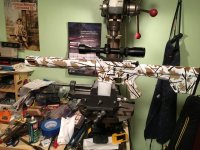So, I am no expert. I watch a LOT of Youtube videos and read a lot of articles to try and understand the principals of things before trying them myself. I have painted a few guns before, but was trying to learn how to do it well.
Lately I have been watching a LOT of vids related to painting my long guns, along with some stuff on ghillie suits, sniper veils, along with military and hunting camo patterns.
In general what I have found is an argument against using the color black, or that the color is excluded.
The argument seems to boil down to "the color black does not exist in nature, so it should not be used in your camo pattern"
I am unclear if animals are not a part of "nature" but last I checked birds, bears, dogs, and many large predators like the tiger, cheetah, and leopard are either entirely black, or use black in their natural camouflage pattern.
I always felt black added depth, or could help to visually break up areas or parts of things.
Should black be used when camo painting a firearm?
Also, here is the collections of videos I have located so far, on painting firearms, that I personally felt worth while.
Best AR15 camo paint job, https://www.youtube.com/watch?v=QsOM6-Rm7KQ&list=PLR31ON9P7uqBNBJ2WRoh1eG4x2YUeph-y&index=1
How Lucas Botkin Paints His Rifles, https://www.youtube.com/watch?v=lx3gErqw0GI&list=PLR31ON9P7uqBNBJ2WRoh1eG4x2YUeph-y&index=2
How To Paint A Rifle Like A Navy SEAL - Coch's Way, https://www.youtube.com/watch?v=wAeSKtluE-c&list=PLR31ON9P7uqBNBJ2WRoh1eG4x2YUeph-y&index=3
How to rattle can your rifle, https://www.youtube.com/watch?v=lgFF6LHOgVw&list=PLR31ON9P7uqBNBJ2WRoh1eG4x2YUeph-y&index=4
How to Paint a Rifle (FOR DUMMIES), https://www.youtube.com/watch?v=eRyUffZ0Kes&list=PLR31ON9P7uqBNBJ2WRoh1eG4x2YUeph-y&index=5
Long Range Shooting, How To Paint a Rifle, https://www.youtube.com/watch?v=nZNp9PoJxeI&list=PLR31ON9P7uqBNBJ2WRoh1eG4x2YUeph-y&index=6
HOW | WHY TO PAINT YOUR RIFLE, https://www.youtube.com/watch?v=SYweeuZDX6U&list=PLR31ON9P7uqBNBJ2WRoh1eG4x2YUeph-y&index=7
How to Paint Your RECCE Rifle, https://www.youtube.com/watch?v=DVSCXCxVF9Y&list=PLR31ON9P7uqBNBJ2WRoh1eG4x2YUeph-y&index=8
DIY Gun Paint Job Tutorial, https://www.youtube.com/watch?v=ghF8L4YjF8w&list=PLR31ON9P7uqBNBJ2WRoh1eG4x2YUeph-y&index=9
Painting Your Rifle the OG Way!, https://www.youtube.com/watch?v=GZG78xjFPBM&list=PLR31ON9P7uqBNBJ2WRoh1eG4x2YUeph-y&index=10
The Joy Of Painting Your Rifle, https://www.youtube.com/watch?v=-YE-Zv76EBc&list=PLR31ON9P7uqBNBJ2WRoh1eG4x2YUeph-y&index=11
Lately I have been watching a LOT of vids related to painting my long guns, along with some stuff on ghillie suits, sniper veils, along with military and hunting camo patterns.
In general what I have found is an argument against using the color black, or that the color is excluded.
The argument seems to boil down to "the color black does not exist in nature, so it should not be used in your camo pattern"
I am unclear if animals are not a part of "nature" but last I checked birds, bears, dogs, and many large predators like the tiger, cheetah, and leopard are either entirely black, or use black in their natural camouflage pattern.
I always felt black added depth, or could help to visually break up areas or parts of things.
Should black be used when camo painting a firearm?
Also, here is the collections of videos I have located so far, on painting firearms, that I personally felt worth while.
Best AR15 camo paint job, https://www.youtube.com/watch?v=QsOM6-Rm7KQ&list=PLR31ON9P7uqBNBJ2WRoh1eG4x2YUeph-y&index=1
How Lucas Botkin Paints His Rifles, https://www.youtube.com/watch?v=lx3gErqw0GI&list=PLR31ON9P7uqBNBJ2WRoh1eG4x2YUeph-y&index=2
How To Paint A Rifle Like A Navy SEAL - Coch's Way, https://www.youtube.com/watch?v=wAeSKtluE-c&list=PLR31ON9P7uqBNBJ2WRoh1eG4x2YUeph-y&index=3
How to rattle can your rifle, https://www.youtube.com/watch?v=lgFF6LHOgVw&list=PLR31ON9P7uqBNBJ2WRoh1eG4x2YUeph-y&index=4
How to Paint a Rifle (FOR DUMMIES), https://www.youtube.com/watch?v=eRyUffZ0Kes&list=PLR31ON9P7uqBNBJ2WRoh1eG4x2YUeph-y&index=5
Long Range Shooting, How To Paint a Rifle, https://www.youtube.com/watch?v=nZNp9PoJxeI&list=PLR31ON9P7uqBNBJ2WRoh1eG4x2YUeph-y&index=6
HOW | WHY TO PAINT YOUR RIFLE, https://www.youtube.com/watch?v=SYweeuZDX6U&list=PLR31ON9P7uqBNBJ2WRoh1eG4x2YUeph-y&index=7
How to Paint Your RECCE Rifle, https://www.youtube.com/watch?v=DVSCXCxVF9Y&list=PLR31ON9P7uqBNBJ2WRoh1eG4x2YUeph-y&index=8
DIY Gun Paint Job Tutorial, https://www.youtube.com/watch?v=ghF8L4YjF8w&list=PLR31ON9P7uqBNBJ2WRoh1eG4x2YUeph-y&index=9
Painting Your Rifle the OG Way!, https://www.youtube.com/watch?v=GZG78xjFPBM&list=PLR31ON9P7uqBNBJ2WRoh1eG4x2YUeph-y&index=10
The Joy Of Painting Your Rifle, https://www.youtube.com/watch?v=-YE-Zv76EBc&list=PLR31ON9P7uqBNBJ2WRoh1eG4x2YUeph-y&index=11

